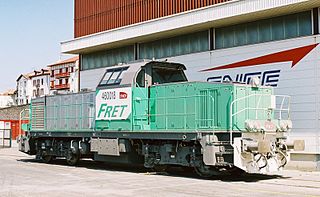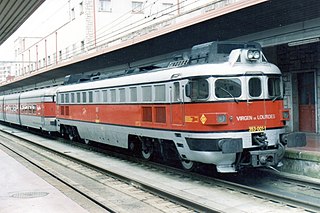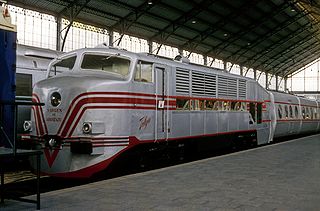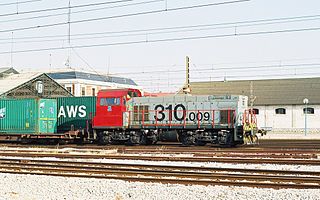| Renfe 334/Vossloh Euro 3000 | |||||||||||||||||||||||||||||||
|---|---|---|---|---|---|---|---|---|---|---|---|---|---|---|---|---|---|---|---|---|---|---|---|---|---|---|---|---|---|---|---|
 | |||||||||||||||||||||||||||||||
| |||||||||||||||||||||||||||||||
| |||||||||||||||||||||||||||||||
| |||||||||||||||||||||||||||||||
| |||||||||||||||||||||||||||||||
| Sources: [4] except where noted | |||||||||||||||||||||||||||||||
The Renfe 334 is a high speed, 4 axle diesel-electric locomotive built to haul passenger trains on Renfe's Talgo service on non electrified lines.
| Renfe 334/Vossloh Euro 3000 | |||||||||||||||||||||||||||||||
|---|---|---|---|---|---|---|---|---|---|---|---|---|---|---|---|---|---|---|---|---|---|---|---|---|---|---|---|---|---|---|---|
 | |||||||||||||||||||||||||||||||
| |||||||||||||||||||||||||||||||
| |||||||||||||||||||||||||||||||
| |||||||||||||||||||||||||||||||
| |||||||||||||||||||||||||||||||
| Sources: [4] except where noted | |||||||||||||||||||||||||||||||
The Renfe 334 is a high speed, 4 axle diesel-electric locomotive built to haul passenger trains on Renfe's Talgo service on non electrified lines.
With the well known Renfe Class 333 locomotives having served for over 30 years the Spanish rail operator faced decisions as to their future. Different options for action were available - rebuild/repair/upgrade the locomotives or replace them with new models; at the time the company was undergoing a major modernisation project - with about 6 billion Euros being invested in rolling stock as part of a 120 billion Euro transport plan. [5]
In the event, acting pragmatically, Renfe chose to do both. The 333 series were extensively rebuilt forming the 333.3 and 333.4 subclasses, and 28 new locomotives were ordered - these were the new build Class 334. A few components were used from old Class 333s, [6] so technically the Class could be considered a rebuild, but the amount of material reused was small so a new class was created.
Renfe worked with Alstom, who then owned the locomotive manufacturing plant in Valencia, to come up with a design for the new locomotives; Alstom Valencia already had produced diesel powered passenger locomotives for the UK and Israel as well as modernising the Renfe class 333.
The design was similar to the modernised 333s but with a General Motors EMD 710 engine instead of the EMD 645 used in the Class 333.4. Additionally 2-axle trucks were used instead of the 3-axle type that were re-used from the original 333 class in the rebuilt 333.4 and 333.3 models.
Curiously the twenty eight Class 334 locomotives inherit the main generator, alternator and heating equipment from Renfe Class 319.3 locomotives - which in turn have inherited the generators and alternators from scrapped Class 333 locomotives. [7] In summary, the engine, electronics and power transmission system are from General Motors, the other components are typical of an Alstom locomotive.
Despite a change of ownership in 2004, with the factory being bought by Vossloh, the production was not affected.
| | This section needs expansion. You can help by adding to it. (January 2009) |

The Class 334 locomotives were originally intended for operations between Madrid, Murcia and Cartagena.
Six units are used to provide an Altaria service between Madrid and Murcia, the regional capital of the region of Murcia. They are also used on the daily Talgo service from Lorca (Murcia) to Montpellier (France) as far as Barcelona.
Four further units provide a Talgo service between Madrid and Almería. Their use also means that it is not necessary to change engines at the Linares-Baeza station in Baeza. [8] [9]
Additionally since 5 units of the Renfe Class 354 are out of action (two destroyed in a head end collision in Linarejos, three others had accidents in Hellín, Tobarra and Chinchilla and another caught fire) the Class 334 have been used to replace them (being the 354 and the 334 the only diesel locomotives capable of 200 km/h in Spain). However the lower power-to-weight ratio compared to the Class 354 units leads to the typical conclusion of lower technical performance for locomotive hauled trains. [6]
Three locomotives are used to replace the Class 354s destroyed at Linarejos (one used as a reserve) and will operate between A Coruña and Madrid. The replacement service began in March 2007 and ends when the construction of a true high speed line is completed. [10]
In 2006 a joint venture between Renfe and Vossloh, Erion, was created, dedicated to servicing and manufacture of rail equipment. Renfe owns 51%, Vossoh 49%. The primary business of the company will be to service the Class 334 locomotives as well as the Renfe Class 333s and Class 335 (Euro 4000). [11] [12] This action has met with criticism from unions as it is part of the process of privatising the Spanish Railways. [13]

Talgo is a Spanish manufacturer of intercity, standard, and high-speed passenger trains. Talgo is an abbreviation of Tren Articulado Ligero Goicoechea Oriol

Alta Velocidad Española (AVE) is a high-speed rail service operated by Renfe, the Spanish State railway company.

The Class 67 locomotives are a class of Bo-Bo diesel-electric locomotives that were built for the English Welsh & Scottish Railway (EWS) between 1999 and 2000 by Alstom at Meinfesa in Valencia, Spain with drive components from General Motors' Electro-Motive Division.

The SNCF Class BB 60000 are a class of 4 axle heavy shunting and light freight diesel–electric locomotives built at the Vossloh España works in Valencia. Since the class is primarily used as a freight locomotive the class is commonly referred to as SNCF BB 460000.

The Stadler Euro is a class of diesel-electric locomotives built by Stadler Rail for the European market. It is available in two basic variants, the four-axle Euro 3000, and the six-axle Euro 4000. These locomotives are powered by EMD 710 prime movers. A six-axle electric-only variant is marketed as Euro 6000; it is also built for the Iberian gauge.

The Prima Diesel-electric locomotives are a class of medium and heavy, four- and six-axle, passenger and freight mainline locomotives. They have been built both to 1,435 mm standard and 1,668 mm broad gauges, and find use in the Middle East, Europe and North America. Alstom is the primary designer in cooperation with both General Motors and Siemens.

The Renfe Series 333 are high power six-axle diesel-electric locomotives built in the 1970s; at the time of their introduction they were the most powerful non-electric locomotives in Spain.

The Renfe Class 353, formerly known as the T-3000 are a class of diesel-hydraulic locomotives built by Krauss-Maffei for express trains in Spain.

The Renfe Class 352 was a class of twin engined four axle diesel-hydraulic locomotives built by Krauss-Maffei, designed solely for passenger traffic; in particular they were responsible for towing Andalusian Talgo III trains. The class were very successful, heralding a new era of passenger trains in Spain. They were delivered in 1964 and 1965, and were fully withdrawn during the 1990s.
Stadler Rail Valencia SAU is a Spanish company, mainly producing products for the railway industry, subsidiary of Stadler Rail.

The Renfe Class 354 was a series of eight diesel hydraulic locomotives manufactured by Krauss-Maffei in Germany specifically to pull Talgo pendular coaches which were introduced shortly before the acquisition of these machines.

The Renfe Class 350 is a series of four single-cabin diesel locomotives that were delivered to Spain in 1950 for use with Talgo II coaches, being built in the United States by the American Car & Foundry to a distinctly American external style.

The Renfe Class 130 or S-130 is a high-speed dual-gauge, dual-voltage trainset consisting of 11 Talgo VII tilting coaches and two power cars, used on Alvia and Euromed services. The class have been nicknamed patitos (ducklings), due to the shape of the train nose.

The Renfe classes 319.2, 319.3 and 319.4 are six axle Co'Co' medium power mainline diesel-electric locomotives manufactured by Macosa using General Motors Electromotive division components under license.

The Renfe Class 309 is a class of 20 three axle diesel-hydraulic locomotives shunters built by M.T.M. for Renfe, and introduced between 1986-7.

The Renfe Class 310 is a class of 60 four axle Bo'Bo' diesel-electric locomotives for shunting and freight built by Meinfesa with General Motors Electromotive Division components.

The Renfe Class 311 is a class of four axle Bo'Bo' diesel electric shunting and light freight locomotives.

Trenhotel was a long distance, overnight train service which used Talgo tilting trains and sleeping cars developed by the Spanish rail network operator Renfe. It was operated by Renfe within Spain, and by its subsidiary Elipsos across France, Switzerland and Italy.

The Stadler Eurolight is the brand name for a family of 4-axle Bo'Bo' mainline diesel-electric locomotives with sub-20-tonne axleloads for passenger and freight trains produced by Stadler Rail.

The JT 42BW is a class of four axle Bo'Bo' diesel electric locomotives manufactured by Alstom's Meinfesa plant in Spain for Israel Railways (IR). The locomotives were the primary passenger locomotive unit used by IR through the 2000s.